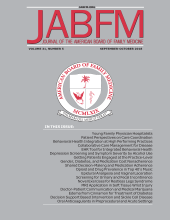Abstract
A second epidemic has appeared among some patients infected with COVID-19 persistent disorders, commonly called “long COVID syndrome.” Our study sought to identify the proportion of French GPs dealing with patients with potential long COVID syndrome and their symptoms in an online cross-sectional questionnaire-based survey among a representative national panel of GPs. The majority (53.8%) reported at least 1 patient with COVID-19 and persistent symptoms, and 33% 2 or more such patients. Their most frequent symptoms were respiratory difficulties (60.6%), psychological distress (42.8%), and anosmia-dysgeusia (40.8%). Long COVID syndrome's recognition, management, and rehabilitation are priorities requiring effective coordination between primary and secondary care.
- COVID-19
- Cross-Sectional Studies
- Family Medicine
- France
- Primary Health Care
- Secondary Care
- Surveys and Questionnaires
Introduction
During a pandemic, primary care professionals play a key role in reinforcing public health messages, helping patients manage at home, and identifying those needing hospital care.1 From the beginning of the COVID-19 pandemic, general practitioners (GPs) have played an important role in patient management. They have had to adapt their practices to deal with a situation constantly evolving2,3 as this new disease's characteristics and management are discovered. Among these characteristics is a secondary epidemic among people who have already been infected with COVID-19: persistent disorders manifested as a wide variety of disabling symptoms affecting up to 30% of patients for several months after the onset of their illness, and known as long COVID syndrome.4 The magnitude of long COVID syndrome is a growing international issue: between May and July 2020, the proportion of patients reporting long-term symptoms in different studies increased sharply5; in France, 60% of patients with COVID-19 included in a longitudinal prospective cohort had at least 1 symptom 6 months after infection.6
Our study sought to identify the proportion of French GPs with patients with potential long COVID syndrome and the symptoms they reported.
Methods
Between October 6 and November 15, 2020, we conducted an online cross-sectional questionnaire-based survey among a representative national panel of 2755 French GPs, randomly selected from the national register of health professionals, about their opinions and practices related to the COVID-19 pandemic.7 Data were weighted for sex, age, workload, region, and density of health care workers in the area of practice and calibrated to take nonresponse into account. The questionnaire asked whether GPs had seen (in person or video) patients with COVID-19 (confirmed cases with PCR testing) whose symptoms persisted for at least 2 months and the types of symptoms they had observed.
Results
Among 1209 participating GPs (44.0%), 53.8% reported at least 1 patient with COVID-19 and persistent symptoms, and 33% 2 patients or more. Reporting patients with long COVID syndrome was significantly more frequent when GPs practiced in areas where the epidemic intensity was highest. It was also positively associated with GP's perception of COVID-19's medical severity (Table 1). They reported a variety of persistent symptoms, most frequently (Figure 1) respiratory difficulties (60.6%), psychological distress (42.8%), and anosmia-dysgeusia (40.8%).
General practitioners' reports of persistent symptoms among patients with COVID-19 (n = 651, weighted data).
Characteristics of General Practitioners According to Long COVID Patients (n = 1209, Weighted Data)
Discussion
More than half of the responding GPs, especially those in areas most strongly affected by the pandemic (62%), have seen patients with what may be long COVID syndrome. Given that the second epidemic wave in France has struck more heavily throughout the country, a higher percentage of GPs may have to deal with this illness. The variety of symptoms mentioned by GPs and the pre-eminence of respiratory and neuropsychological symptoms, loss of smell and/or taste are in line with previous publications; some also identified fatigue as a frequent symptom of long COVID syndrome (symptom not included in our questionnaire).4,8
Because guidelines for diagnosing and managing patients with long COVID syndrome were published only recently in France,9 GPs and patients have inhabited an evidence-free zone.10 Patients with long COVID syndrome reported feeling that their GPs frequently did not believe, listen to, or support them, as they endured disabling symptoms.11 The GPs can encounter diagnostic uncertainties when a laboratory test cannot confirm the primary infection because of the unspecific nature of some long COVID symptoms. Diagnosing this syndrome requires eliminating a known identifiable condition, such as pulmonary fibrosis, asthma, decompensation of a comorbidity, and other causes besides COVID-19.12
The World Health Organization has urged countries to prioritize recognition, research, and rehabilitation of long COVID syndrome.13 A better understanding of the risk factors for long COVID symptoms is an essential research issue to adapt the follow-up and management of these patients. Services should be multidisciplinary, run by primary care professionals to enable continuity in follow-up and rehabilitation, with appropriate links for secondary care referral.14 The recent French reform based on “territorial professional health communities” intended to better organize collaboration and coordination between health professionals of primary and secondary care for the patient's path, across the territories, offers an opportunity to manage these new complex patients.
Notes
This article was externally peer reviewed.
Funding: The panel of French GPs is funded by the Direction de la recherche, des études, de l'évaluation et des statistiques (Drees) / Ministére des solidarités et de la santé.
Conflict of interest: None.
To see this article online, please go to: http://jabfm.org/content/34/5/1110.full.
- Received for publication April 2, 2021.
- Revision received May 17, 2021.
- Accepted for publication June 4, 2021.








